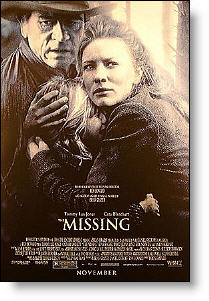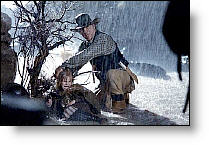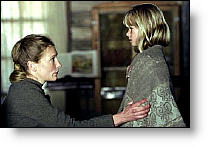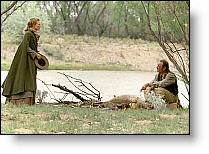The Missing
 for violence.
for violence.
Reviewed by: Todd Campbell
CONTRIBUTOR
| Moral Rating: | Average |
| Moviemaking Quality: |
|
| Primary Audience: | Mature-Teens Adults |
| Genre: | Western Drama |
| Length: | 2 hr. 10 min. |
| Year of Release: | 2003 |
| USA Release: |






murder in the Bible
FILM VIOLENCE—How does viewing violence in movies affect families? Answer
| Featuring |
|---|
| Tommy Lee Jones, Cate Blanchett, Evan Rachel Wood, Aaron Eckhart, Jenna Boyd |
| Director |
|
Ron Howard |
| Producer |
| Brian Grazer, Daniel Ostroff |
| Distributor |
| Revolution Studios |
Magdalena “Maggie” Gilkenson is a healer, a rancher, and a mother of two who has her hands full taking care of her family in 1885 New Mexico, even with the help of her lover and a Mexican ranch hand. Her estranged father (Tommy Lee Jones) arrives after twenty years of absence and seeks her healing touch. She treats him but orders him off her ranch, given his neglect of her for so long.
While branding the new calves, her lover and the ranch hand are murdered and her daughter Lily is kidnapped. Thinking that her father is the culprit, Maggie heads to town where the sheriff notifies the proper authorities but does little else, forcing Maggie to take matters into her own hands and set off with her Apache-saavy father and her spunky daughter Dot to find Lily and hopefully rescue her. The Gilkensons follow right behind the Apache witch who is collecting women to sell as slaves to comancheros in Mexico, but as they draw nearer to saving Lily, minor mishaps occur which make things even harder to rescue Lily and the other girls from their captors.
Morality Issues
The language in the movie is somewhat mild, with a few sexual references and the use of the s-word in a few places, but in general, the language is not as strong as it would have been with most directors. Some will find the scenes of Native American shamanism/witchcraft offensive, but the scenes are usually brief.
Some sexuality is presented such as the attempted rape of one of the captive women and the suggestion that Maggie became pregnant with Lily as a result of a rape. “She’s a Christian woman,” or so says Maggie’s lover and right hand man on the ranch, but she and the man are not married, though his marriage proposals have been rejected. Some sexuality is hinted at between the captives and their kidnappers, but most of it is either talk or attempts. In this regard, the Native Americans are portrayed as being more respectful of the women than their Caucasian counterparts who treat the women horribly.
The violence is a bit more than what one would expect from a Western. (This movie really is a Western, despite what the commercials make it appear.) A number of people are shot, a couple of knife fights occur, and two people are beaten to death with a large bone while others are cut with claws that have been dipped in rattlesnake poison. Perhaps the most disturbing image is the remnant of what happened to Maggie’s lover, shown in the beginning of the movie, when he was apparently wrapped in a cowhide bag and set over a bonfire to roast to death. One person is beaten to death by the Apache kidnappers and his body is left on the rocks. In the scenes where a person is beaten to death, the scene usually shifts so we don’t see the actual blows but merely the action of them, with a bloody bone mallet being the only evidence of the actual violence. A young mother commits suicide over the death of her baby girl. One person’s heart is supposedly cut out, but we never see the heart, only a buried pink bag that supposedly contains the heart. In one scene, a young child is endangered by rattlesnakes suspended from tree branches.
Spiritual Issues
Marriage is treated as a somewhat important concept in this movie, though the Native Americans show greater reverence to their families than do the Gilkensons. Maggie’s father left her when she was fairly young and apparently led a less than savory life among the tribes he spent time with; he returns to her to ease his soul. Even the Native Americans saw the man as worthless because he had no family, which suggests one Biblical link that a man’s greatest responsibility is to support his family, an obligation second only to loving God with his entire being. Maggie, on the other hand, refuses to marry her top ranch hand, so she lives with him instead, having sex with him only when her daughters are asleep and cannot hear them.
A person’s family is an incredibly precious gift from God, and we should be thankful that we have a family. Lily learns this lesson as early in the movie she comments that she “was born in the wrong family” and that she’s going to leave them as soon as she can. Lily’s character comes across as a spoiled teenager, except that she is still forced to do chores around the house, like field dressing deer and branding the new cattle, though she wears her Sunday best when she helps out. Lily realizes the power of family, seemingly too late to appreciate them.
Another spiritual issue that plays more in the commercials than in the movie is the concept of witchcraft. The bruja/witch in the movie does little more than cast curses on two people and harness rattlesnake venom to make his weapons more deadly; otherwise the “medicine man” concept is nothing, though the scenes with the witch are somewhat disturbing visually since he usually has rattlesnakes around him. Of the two people who were cursed, only Maggie did not suffer significantly from the fatal effects of the curse placed on her.
Maggie, being a “Christian woman,” wears a cross for most of the movie, but her obvious lack of faith in Christ is what caused her to suffer from the curse, not her lack of faith in Native American medicine. Had Maggie been a true Christian, a woman who was willing to forgive her father for abandoning her so long ago, a woman who did not sleep with a man who was not her husband, then she might not have felt any effects from the curse since God protects us all and has a purpose for everything in our lives. Still, the scene where her father, their Native American friend, and Dot are chanting/praying over her is intriguing because they combine Native American ways with passages from the Gospels.
God’s power is almighty and everlasting; who is mightier than our God? None, regardless of culture or belief system, for God is our sole/soul protection from evil and the dangers the enemy tries to inflict. To an extent, this movie reminded me somewhat of Job who lost his possessions, his family, and his health, but still he would not curse God.
Opinion
Overall, I thought this movie was going to be heavy in the shamanism/medicine man material, but it proved to be a true shoot ’em up Western, very similar to “The Searchers” (1956) or “The Shadow Riders,” with bits of “Unforgiven” thrown in for good measure. I would recommend, with reservations, this movie to older fans of Westerns, especially since Hollywood rarely produces any good Westerns with little language, little sex, and the traditional cowboy violence. Do not bring children to this movie. [Remember, it is rated “R”.]
Violence: Moderate | Profanity: Mild | Sex/Nudity: Mild


Overall, it is a good movie. It isn’t Howard’s best film, but is still well made and well acted, especially by Cate Blanchett.
[Average/4]
[Average/4]
The witch doctor in the movie was portrayed as being demonicaly evil. The movie did not romanticize witchcraft and spell casting at all. It was completely evil. The scenes with the shaman were extremely gory and violent, but isn’t that how Satan is?
This movie was a good reminder that there is a spiritual world present that we usally don’t see. There is God, but there is also a devil. In the same way God’s Holy Spirit lives in and works through believers of Christ, the same is true for Satan living in and working through his “believers”.
The movie does a good job of showing the effects of evil control on a person’s life. In one scene, the young girl was reading aloud God’s Word along with 2 others who were giving Indian chants to help fight off an evil spell cast on the girl’s mother, who was a Bible-believing woman. In an earlier scene the woman had her daughter recite the 23rd Psalm to calm an elderly sick women. I wished the movie would have emphasized the power of God and His word more, but maybe that was all the film maker had to offer us.
The characters were not, “let’s just forgive and forget” type people with a “happily ever after” ending. They were tough people who had to harden themselves to survive the hard life they lived. Most movies portray everyday people as extraordinary or heroic. Not in this movie. There were several opportunities for sex scenes, but I was pleasantly surprised, there were none. I can’t remember any swearing either.
This movie is not for the faint of heart, nor is it for young viewers. It’s intense, very violent and gory in parts. Though the movie was heavy and somewhat depressing, I really liked it. It was a good reminder of the reality of evil and the peace we have knowing that the power of the risen Savior lives in me and is bigger then any forces of evil I may encounter. The Bible says, with God all things are possible. Greater is He that is in me, than he that is in the world.
[Better than Average/3]
[Very Offensive/4]
From a Christian viewpoint it has objectionable themes. Tommy Lee Jones’ character has lived with Indians and has adopted their religious beliefs and practices, including a mystical communication with some animals. The most objectionable theme is presented in a scene where an Indian witch uses something akin to voodoo to cast a curse on Maggie. The curse is defeated with Indian remedies (a curse-protecting necklace, incense, and incantations) and also Bible reading. The critics will undoubtedly rave over this movie because it is so well-made and because it is multi-cultural, implying that Indian religious practices are equivalent to Christianity.
My Ratings: [Average/4]